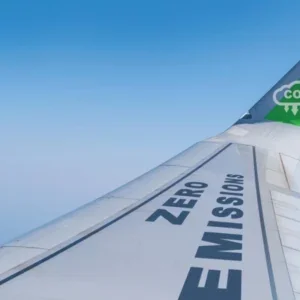Long before the widely publicised COP21 climate summit, held a year ago in Paris, the aviation industry had been scoring significant victories on climate-change issues. However, during the week-long Paris negotiations the spotlight fell on an active commitment made by the International Civil Aviation Organization (ICAO), the UN’s specialised agency for aviation, and the aviation industry, represented by the Air Transport Action Group (ATAG).
The initiative involving the two industry bodies was born in September 2013, and brings together 191 member states, 1,860 airports, 240 international airlines, 80 air-transport management bodies, industry unions and aerospace manufacturers, all working towards the common goal of reducing the sector’s environmental footprint and thus actively preventing its impact on climate change. An official agreement signed by state leaders at the end of the 38th ICAO Assembly marked a significant moment in advancing these common goals, which had been first outlined by the sector in 2008.
“This is clearly a historic resolution,” said former ATAG executive director Paul Steele at the time, “showing the leadership of both developed and developing-country governments meeting at ICAO in driving the first comprehensive agreement on climate change for any global sector.”
Since then, hundreds of local, national and international partnerships, programmes, projects and initiatives have been set up across the world, representing the “tip of the iceberg of a massive energy-efficiency movement in aviation”, according to ATAG’s current executive director, Michael Gill.
But, as the industry itself has recognised, more work remains to be done if the sector is to achieve carbon-neutral growth within four years, as well as the long-term ambition to halve net CO2 emissions by 2050 from 2005 levels.
A raft of market-based measures for international aviation has been devised for the first time as a result of this partnership. Ahead of the initiatives’ evaluation at the next ICAO Assembly in 2016, what major efficiency achievements have been realised within the industry? And what are the next parameters for progress?
Industry achievements so far
As a transporter of people and goods, aviation is one of the leading contributors to the socio-economic development of the entire world, generating $2.2 trillion of GDP annually. But despite being “one of the most technologically advanced and innovative sectors in the world” according to ATAG, the industry currently emits around 2% of human CO2 emissions every year, or 724 million tons, as recorded in 2014.
In plain terms, a passenger flying on a round trip between London and New York generates roughly the same level of emissions as the average EU citizen creates by heating their home for an entire year, according to the European Commission website.
Due to its international nature, the sector cannot be regulated by national laws, which is why the aviation and maritime sectors were excluded from the formal agreements during the COP21 negotiations – a decision that drew some criticism at the time. However, the elevated emissions levels created by this rapidly growing sector has resulted in mounting pressure for the aviation industry to act quickly, and demonstrate leadership.
Many players in the industry have done just that. In July 2014, the ICAO counted 74 member states, representing 82% of global international air traffic, that have submitted national action plans mapping out their strategies for cutting aviation emissions. Moreover, 91 states – equivalent to 93% of air traffic – received training and had undergone a host of capacity-building activities to help reduce their CO2 emissions.
The most successful 101 case studies to date, involving more than 400 organisations spread across 65 countries worldwide, have been compiled by ATAG in its ‘Aviation Climate Solutions’ report, published in September of last year.
At a glance, the report counts more than 100 airports worldwide that use solar power as an energy source, over 2,000 commercial flights running on sustainable alternative fuels, and a total reduction of around 56 million tons of CO2 during the past 15 years due to 8,300 aircraft using wingtip devices.
Among the diverse programmes outlined in the report, highlights include 20 European airports achieving full carbon neutrality; the launch of 12 fuel-efficient aircraft types that are already in operation; and more than $15 billion spent annually by manufacturers on further research and development of newer aircraft types expected to enter the market over the next ten years. Moreover, airlines have already signed forward-purchase agreements with alternative-fuel suppliers for up to 340 million litres of fuel for the next ten years.
It was through these collaborations and technological innovations that the industry managed to exceed its first goal, set six years ago: by the end of 2015, the sector achieved 2.9% annual fuel efficiency improvements – a great leap from the initial 1.5% figure laid down ahead of the original 2020 deadline.
“While the 101 case studies here provide only a snapshot of the many thousands of projects taking place across the industry, they do give a good flavour of the variety and scope of the industry’s efforts,” Gill writes in the report’s introduction. “Some actions are big, such as bringing a new aircraft to service; and some are smaller, but significant in their own way. This is a reflection of the aviation industry as a whole.”
A roadmap for sustainability
However, the battle is far from over. As with many other industries, aviation has a moral responsibility to align its operations within the global 2°C scenario, which aims to cut energy-related CO2 emissions by more than half by 2050.
“The ICAO, governments, civil society and the industry are working in partnership to deliver a robust worldwide measure that will enable the achievement of the ICAO’s aspirational goal to stabilise international aviation’s net CO2 emissions,” a joint-action statement reads.
But as positive as the plans might sound, it may still not be enough. A 2015 study commissioned by the EU Parliament for the Committee on the Environment, Public Health and Food Safety warns that these goals are not sufficiently ambitious.
“Initiatives and actions taken by the ICAO and IMO to address greenhouse gas emissions started late, and have been insufficient from an environmental perspective to date: they do not take appropriate account of global decarbonisation requirements,” the report states. “In the long term, these measures will mitigate growth of the sectoral CO2 emissions, but not lead to absolute emission reductions.”
Nevertheless, a detailed action plan submitted in September 2014 ahead of the UN’s Climate Summit outlines the three main goals between the present and 2050, as well as presenting the four central pillars of climate action necessary to make these goals a reality.
First, the plan lists the ambition to settle on a 1.5% average annual fuel-efficiency improvement before 2020. As the current 2.9% figure is expected to normalise and level out, Gill points out that airlines will need to invest around $1.3 trillion in new aircraft by 2020 in order to keep to the original target.
Second, the sector aims to stabilise net emissions from 2020 through carbon-neutral growth, followed by the most ambitious venture: reducing net aviation carbon emissions 50% by 2050, relative to 2005 levels, regardless of growth in passenger numbers and cargo.
ATAG’s agenda includes a host of complex measures falling within four main categories: technological innovation, operational improvements, infrastructure efficiencies and smart economic measures.
In February, after six years of development, a new aircraft CO2 emissions standard was agreed by the ICAO’s Committee on Aviation Environmental Protection (CAEP), the first ever to impose binding energy efficiency and CO2 reduction targets for the aviation sector. The environmental measure was unanimously recommended by the 170 international experts on CAEP. The incentive is twofold: advancing fuel efficiency would tackle what currently represents the biggest cost for airlines, which stood at $210 billion in 2014.
Potentially one of the most significant moves on the agenda is implementing the Global Air Navigation Plan 2013–2028 – a strategic approach delivered in “block upgrades” within participating member states that helps reduce emissions through the delivery of advanced air-traffic management systems.
“The global plan has been developed as a set of ‘block upgrades’ that member states can implement in line with national circumstances and the availability of technology,” the document reads. “Many of the blocks will allow better use of airspace capacity, providing room for air traffic to grow while reducing inefficiencies in the system, and emissions.”
Furthermore, the final action pillar looks at designing a global market-based measure (MBM) for international aviation in the form of emissions trading, emission-related levies such as charges and taxes, and emissions offsetting. The MBM will be considered in depth at the 39th ICAO Assembly later this year, with scope to be implemented from 2020.
Making the case for this complex but crucial roadmap of actions, an open letter signed by 28 aviation industry chief executive officers and association leaders ahead of COP21 urged governments to fully commit to the upcoming challenge of revolutionising air transportation.
“The support must take place through a range of actions: air-traffic management investment and reform; continued support for research into new technology, operations and sustainable alternative fuels; improved intermodal transport planning; and the right policy framework to help accelerate the availability of sustainable alternative fuels for aviation,” the letter reads.
“To delay will harm a vital global sector, and harm our global climate.”






